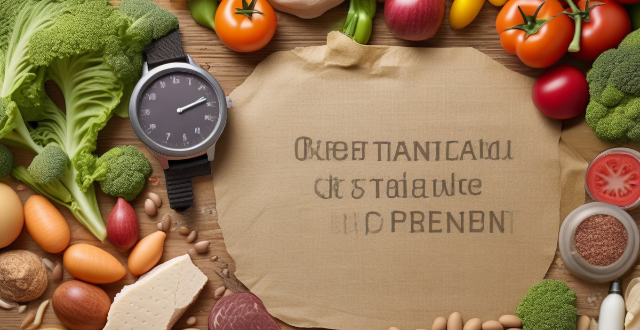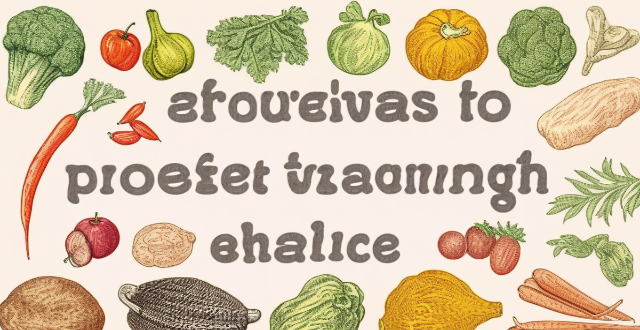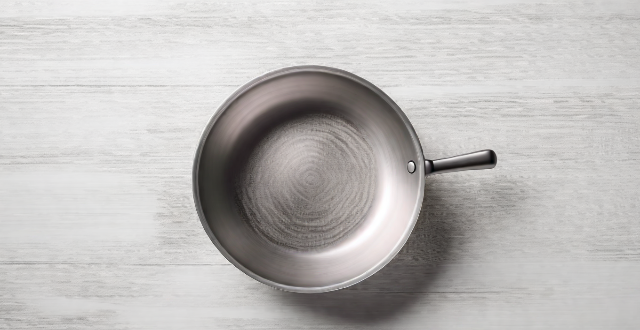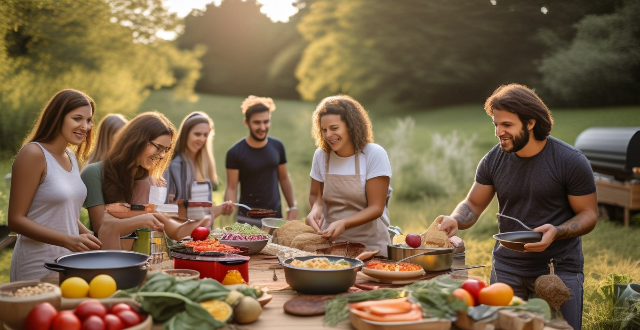Cooking Vegetarian

What are some creative ways to use tofu in vegetarian cooking ?
Tofu is a versatile and nutritious ingredient that can be used in a variety of vegetarian dishes. Here are some creative ways to use tofu in your cooking: marinated and grilled tofu skewers, creamy tofu pasta sauce, tofu stir-fry, tofu bao buns, tofu scramble, and tofu dumplings. By incorporating these ideas into your vegetarian cooking, you can enjoy the many health benefits of tofu while exploring new flavors and textures in your meals.

How can I make my favorite dishes vegetarian without sacrificing flavor ?
How to Make Your Favorite Dishes Vegetarian Without Sacrificing Flavor

What are some vegetarian Italian pasta recipes ?
Italian cuisine is known for its delicious pasta dishes, and there are plenty of vegetarian options to choose from. Here are some vegetarian Italian pasta recipes that you can try: 1. Spaghetti with Tomato Sauce 2. Mushroom Stroganoff 3. Pesto Pasta 4. Roasted Vegetable Pasta 5. Creamy Spinach Pasta

How do I ensure I'm getting enough nutrients on a vegetarian diet ?
This topic discusses the essential nutrients to watch on a vegetarian diet and provides tips for meal planning. It highlights key nutrients such as protein, iron, vitamin B12, calcium, vitamin D, and omega-3 fatty acids and suggests food sources for each. The text also emphasizes the importance of diversifying intake, considering supplementation, having regular check-ups, and working with a professional to create a balanced meal plan. Overall, it offers guidance on ensuring adequate nutrient intake while following a vegetarian diet.

What are some vegetarian recipes that are also gluten-free ?
This text provides three vegetarian and gluten-free recipes that are both nutritious and delicious. The first recipe is for lentil soup, which is a hearty and filling meal. The second recipe is for quinoa salad, which is a great source of protein and makes an excellent base for a salad. The third recipe is for zucchini noodles with pesto sauce, which is a fantastic gluten-free alternative to traditional pasta. These recipes showcase the diversity of flavors and textures that can be achieved on a vegetarian and gluten-free diet.

What are the most popular vegetarian dinner recipes ?
Vegetarian dinner recipes have become increasingly popular in recent years as people are looking for healthier and more sustainable food options. Here are some of the most popular vegetarian dinner recipes: 1. Lentil Soup: A hearty and filling meal that is perfect for colder months, packed with protein, fiber, and nutrients. 2. Chickpea Curry: A flavorful and satisfying dish that is easy to make, perfect for those who love Indian cuisine. 3. Roasted Vegetable Quinoa Bowl: A healthy and colorful meal that is perfect for meal prep, packed with vegetables, protein, and fiber.

Can following a vegetarian or vegan diet be considered healthy ?
A vegetarian or vegan diet can indeed be considered healthy, but it depends on how well-planned and balanced the diet is. Here's a detailed analysis: ## **Nutritional Requirements** ### *Protein* Vegetarians can get protein from sources like beans, lentils, tofu, tempeh, and dairy products. Vegans need to rely on plant-based proteins such as legumes, grains, nuts, and seeds. ### *Iron* Plant-based sources of iron include leafy greens, beans, and fortified cereals. However, the absorption rate of non-heme iron (from plants) is lower than heme iron (from animals). Consuming vitamin C-rich foods can enhance iron absorption. ### *Calcium* Vegetarians can get calcium from dairy products. Vegans need to find sources like fortified plant milks, tofu, and certain greens. ### *Vitamin B12* This nutrient is only found naturally in animal products. Vegetarians who consume dairy or eggs don't usually have a deficiency, but vegans must rely on fortified foods or supplements. ### *Omega-3 Fatty Acids* Flaxseeds, chia seeds, hemp seeds, and algae-based supplements are good sources for vegans. Vegetarians can also get it from fish. ## **Potential Health Benefits** - **Lower Risk of Chronic Diseases**: Studies show that vegetarian and vegan diets can reduce the risk of heart disease, high blood pressure, type 2 diabetes, and obesity. - **Healthier Weight**: Plant-based diets tend to be lower in calories and higher in fiber, leading to better weight management. - **Rich in Antioxidants**: Fruits, vegetables, whole grains, and legumes are rich in antioxidants, which help fight inflammation and cellular damage. ## **Challenges and Considerations** - **Nutrient Deficiencies**: Without proper planning, vegetarians and especially vegans may face deficiencies in certain nutrients like vitamin B12, iron, calcium, and omega-3 fatty acids. - **Limited Food Choices**: Avoiding entire food groups can make meal planning more challenging and limit variety. - **Social and Cultural Factors**: Eating out or attending social events where vegetarian or vegan options are not readily available can be difficult. ## **Conclusion** Adopting a vegetarian or vegan diet can be very healthy if it is well-planned and balanced to meet all nutritional needs. It's essential to ensure adequate intake of key nutrients that might be lacking in plant-based diets. Consulting with a registered dietitian can help individuals navigate these challenges and create a sustainable, healthy eating plan.

What are some go-to vegetarian or vegan home-cooked options ?
Vegetarian and vegan home-cooked options are not only delicious but also healthy and environmentally friendly. Here are some go-to vegetarian or vegan home-cooked options: 1. Lentil Soup: A hearty and nutritious option for vegetarians and vegans. It is easy to make and can be customized with different vegetables and spices. 2. Chickpea Curry: A flavorful and filling dish that is perfect for vegetarians and vegans. It is made with chickpeas, vegetables, and spices. 3. Quinoa Salad: A healthy and versatile option for vegetarians and vegans. It can be made with different vegetables and dressings.

What are some ways to organize my kitchen to make cooking more efficient ?
Organizing your kitchen can greatly enhance the cooking experience by making it more efficient and enjoyable. Here are some strategies to consider: 1. Zone Cooking Areas 2. Declutter Regularly 3. Smart Storage Solutions 4. Group Like Items Together 5. Maximize Fridge and Freezer Space 6. Keep a Clean Sink 7. Lighting and Safety

How can I streamline my cooking process to save time in the kitchen ?
The text provides tips and tricks for streamlining the cooking process, including planning ahead, using slow cookers or pressure cookers, prepping ingredients in advance, cooking once and eating multiple times, and cleaning as you go. These strategies aim to save time, reduce stress, promote healthy eating, and create a more enjoyable cooking experience by emphasizing preparation and organization.

Can you explain the different types of cooking pans and their uses ?
The text provides a detailed overview of different types of cooking pans, highlighting their specific uses and features. It covers non-stick pans, cast iron pans, stainless steel pans, copper pans, aluminum pans, grill pans, skillets, saucepans, and griddle pans. Each type of pan is described in terms of its ideal uses and unique characteristics, such as heat conductivity, maintenance requirements, and compatibility with various cooking methods and materials. The summary emphasizes the importance of using the right pan for a given task to achieve optimal cooking results.

What are the key ingredients in Indian cooking ?
Indian cuisine is known for its rich flavors and diverse dishes. The key ingredients that make Indian cooking unique are spices, herbs, ghee, lentils, rice, yogurt, nuts and seeds, and bread. These ingredients add flavor, color, and aroma to the dishes and create authentic and delicious Indian cuisine.

What are the basic techniques used in Chinese cooking ?
Chinese cuisine is known for its diverse flavors and cooking techniques. Here are some of the basic techniques used in Chinese cooking: 1. Stir-frying involves quickly frying small pieces of food in a wok or frying pan over high heat. The key to successful stir-frying is to use hot oil, fresh ingredients, and constant motion to prevent burning. 2. Steaming involves placing food in a steamer basket over boiling water and allowing it to cook through steam. This method is often used for dumplings, buns, fish, and vegetables. 3. Braising is a slow-cooking method that involves simmering meat or vegetables in liquid until they become tender and flavorful. This technique is often used for stews, soups, and braises. 4. Deep-frying involves submerging food in hot oil until it becomes crispy and golden brown. This technique is often used for fried rice, spring rolls, and tempura dishes. 5. Roasting involves cooking food in an oven at high temperatures until it becomes caramelized and tender. This technique is often used for roasted meats, vegetables, and baked goods like mooncakes and egg tarts.

What are the best techniques for cooking seafood ?
The article provides a summary of the best techniques for cooking seafood, which include poaching, grilling, steaming, and baking. Poaching is a gentle method of cooking seafood in a flavorful liquid such as water, broth or wine. Grilling is ideal for firm-fleshed fish like salmon or swordfish and adds flavor and texture to seafood. Steaming is a healthy way to cook seafood without adding extra fat and works well for fish fillets or shellfish like clams or mussels. Baking is a dry heat method that works well for thicker cuts of fish like cod or haddock. The article emphasizes the importance of paying attention to timing and temperature to avoid overcooking seafood.

How can I use kitchen appliances to save time while cooking ?
Using kitchen appliances like food processors, slow cookUsing kitchen appliances like food processors, slow cookers, rice cookers, slow cookers, electric pressure cookers, rice cookers, and stand mixers can significantly save time in meal preparation. These appliances offer features such as chopping, grinding, making dough, cooking at different heat settings, and precise mixing, allowing for efficient and convenient cooking experiences.

How does proper cooking and baking contribute to food safety ?
Food safety is crucial for maintaining public health and preventing illnesses. Proper cooking and baking are vital components of food safety, as they can destroy harmful microorganisms that may contaminate raw ingredients. High temperatures during cooking and baking kill most bacteria, reduce viruses, and eliminate parasites. Additionally, proper cooking practices prevent cross-contamination by using separate utensils and cutting boards for different types of food. To ensure food safety during cooking and baking, it's essential to use a food thermometer to check the internal temperature of cooked foods, follow recipes and time guides, keep work surfaces and equipment clean, store raw and cooked foods separately, avoid overcrowding pans, and refrigerate leftovers promptly. By adopting these best practices, you can significantly minimize the risk of foodborne illnesses and enjoy safe, delicious meals.

What are the most common mistakes when cooking lobster at home ?
Cooking lobster at home can be delightful but common mistakes can affect taste and texture. Here are the most frequent errors: 1. **Not Preparing the Lobster Properly** - Underestimating the amount of salt needed for cooking water. - Ignoring the rinse before cooking to remove sand or grit. 2. **Overcooking the Lobster** - Cooking too long results in tough and chewy lobster. - Lack of temperature control during cooking. 3. **Choosing the Wrong Lobster** - Selecting poor quality or lethargic lobsters. - Neglecting size variation leading to uneven cooking times. 4. **Disregarding Safety Precautions** - Handling live lobsters incorrectly, risking injury. - Ignoring cross-contamination with other foods. 5. **Inadequate Flavoring** - Skipping seasoning, missing out on enhancing natural sweetness. - Overlooking garnishes that can improve the dining experience. 6. **Improper Storage and Handling** - Storing improperly if not cooked immediately. - Delaying cooking after purchase, risking the quality of the lobster. By avoiding these mistakes, you can ensure that your homemade lobster dishes are delicious and succulent.

How can I reduce the amount of cleaning required after cooking a meal ?
Cleaning up after cooking can often feel like a chore, especially after spending time preparing a delicious meal. However, there are several strategies you can implement to minimize the mess and make cleaning up quicker and easier. Here's a detailed guide on how to reduce the amount of cleaning required after cooking: Before You Start Cooking - Plan Ahead: Decide what you will cook and read through the recipe completely. This helps you prepare all necessary ingredients and tools beforehand, reducing the need to clean up multiple times during cooking. Prep Your Workspace: Clear your countertops and clean them thoroughly before you start cooking. A clean work area means less mess to clean up later. Use Non-stick Cookware: Non-stick pans and bakeware require less oil or butter, making them easier to clean with just a quick wipe down. Set Up a Spill Station: Place a sheet of foil under or beside the stove to catch drips and spills, which can be easily thrown away after cooking. While You Are Cooking - Clean as You Go: Wash utensils and dishes immediately after using them. This prevents food residue from drying up and becoming harder to clean. Use Covers on Pots and Pans: This reduces splatters and saves you from having to wipe down the stove and surrounding surfaces. Contain Small Messes: Use a small bowl to hold waste like vegetable peels or fish bones rather than letting them spread over the counter. After You Have Cooked - Soak Dishes: If you have dishes that are difficult to clean, fill them with hot water and a little detergent to soak while you eat. This makes them much easier to clean later. Wipe Down Appliances: Give your appliances like blenders, mixers, or food processors a quick wipe down after use to remove any splatters. Clean the Stove Top and Countertops: Wipe these areas down with a damp cloth after cooking to avoid crusty buildup. General Tips for Efficiency - Simplify Your Recipes: Opting for simpler recipes can reduce the number of dishes used and ingredients prepared. Cook One-Pot Meals: One-pot meals like stews, casseroles, or stir-fries require fewer dishes to wash. Use Disposable Items Wisely: While not environmentally friendly, disposable items like baking paper, foil, or paper plates can be used strategically in situations where cleanup is particularly challenging.

How do I choose the right type of rice for Chinese cooking ?
When it comes to Chinese cooking, selecting the rightWhen it comes to Chinese cooking, selecting the right for achieving the desired texture and selecting the right type of rice is crucial for achieving the desired texture and flavor in your dishes. Consider the dish you are making, look for quality and freshness when purchasing rice, and don't forget to consider your personal preferences. By following these steps, you can choose the perfect type of rice for your Chinese cooking needs.

Can vegetarians enjoy a variety of Indian food ?
Vegetarians can enjoy a variety of Indian food due to the country's diverse cuisine and common dietary choice. Traditional vegetarian dishes like Chana Masala and Palak Paneer offer delicious options, while regional variations such as South Indian Dosas and Gujarati Thali provide unique flavors. Street food also presents numerous vegetarian choices like Pani Puri and Vada Pav. Additionally, global influence has led to more vegetarian versions of classic dishes in restaurants worldwide.

How do I make vegetarian versions of classic comfort foods ?
Vegetarian versions of classic comfort foods can be just as satisfying and delicious as their meat-based counterparts. Here are some tips on how to make vegetarian versions of classic comfort foods: 1. Start with a hearty base like lentils, beans, or tofu. 2. Add rich flavors like cheese, cream, or butter. 3. Use spices and herbs for depth and complexity. 4. Get creative with grains like rice, quinoa, or pasta. 5. Incorporate vegetables by roasting, sautéing, or adding raw to salads. 6. Try meat alternatives like plant-based burgers, sausages, and bacon. 7. Experiment with different cuisines for new and exciting ways to enjoy your favorite comfort foods without meat.

Can you suggest some vegetarian meal prep ideas for busy weekdays ?
Vegetarian meal prep ideas for busy weekdays include roasted vegetable bowls, lentil soup, chickpea salad sandwiches, veggie burgers, and quinoa stir fry. These meals are packed with nutrients, flavorful, and convenient for busy schedules. By planning ahead and preparing these meals in advance, you can ensure that you have healthy and tasty options available throughout the week without sacrificing time or effort.

What are some good options for quick and easy vegetarian meals ?
Vegetarian meals can be quick and easy to prepare. Here are some options: stir-fry vegetables with rice or noodles, quinoa salad with roasted vegetables, vegetable soup or broth, veggie burgers with avocado and salsa, and pasta with pesto and cherry tomatoes. These meals can be customized based on preferences and what's available in the kitchen.

What are some vegetarian or vegan breakfast options that provide enough energy ?
The given vegetarian or vegan breakfast options are packed with nutrients and provide sufficient energy to start the day. Tofu scramble is a protein-packed dish that can be made versatile by adding various vegetables. Oatmeal with fruits and nuts is high in fiber and healthy fats, providing sustained energy throughout the morning. Smoothie bowls are customizable and quick to make, while avocado toast is rich in healthy fats and can be made gluten-free. Overall, these breakfast options offer numerous health benefits due to their nutrient content and can help individuals start their day off right.

What are some vegetarian or vegan breakfast options that are still tasty and satisfying ?
The text provides a list of vegetarian or vegan breakfast options, including avocado toast, oatmeal with fruit and nuts, tofu scramble, chia seed pudding, smoothie bowl, veggie omelette, and peanut butter banana wrap. Each option is described in terms of ingredients and preparation methods. The options are not only delicious but also provide a balanced mix of protein, healthy fats, and complex carbohydrates to keep you full and energized throughout the morning.

What are some easy and delicious vegetarian recipes for beginners ?
Vegetarianism is a popular dietary choice, but it can be daunting for beginners to find easy and delicious recipes. Here are some simple vegetarian dishes that are perfect for those new to plant-based eating: ## **1\. Roasted Vegetable Pasta** This colorful pasta dish is packed with flavor and nutrition. **Ingredients:** * 1 cup cherry tomatoes, halved * 1 zucchini, sliced * 1 red bell pepper, sliced * 1 yellow onion, chopped * 2 garlic cloves, minced * 8 oz whole wheat pasta * 2 tbsp olive oil * Salt and pepper to taste * Fresh basil leaves for garnish **Instructions:** 1. Preheat oven to 400°F (200°C). 2. Toss the vegetables in olive oil, salt, and pepper. 3. Arrange the vegetables on a baking sheet and roast for 25 minutes or until tender. 4. Cook the pasta according to package instructions. 5. In a large bowl, combine the roasted vegetables and cooked pasta. 6. Garnish with fresh basil leaves and serve warm. ## **2\. Chickpea Curry** This creamy and flavorful curry is perfect for beginners. **Ingredients:** * 1 can chickpeas, drained and rinsed * 1 onion, diced * 2 garlic cloves, minced * 1 tbsp curry powder * 1 tsp ground cumin * 1 tsp ground coriander * 1 tsp turmeric * 1 can coconut milk * Salt to taste **Instructions:** 1. Heat a pan over medium heat and add a tablespoon of oil. 2. Sauté the onion and garlic until soft. 3. Add the spices and cook for another minute. 4. Stir in the chickpeas and coconut milk. 5. Bring to a simmer and cook for 10 minutes or until the sauce thickens. 6. Season with salt and serve hot with rice or naan bread. ## **3\. Lentil Soup** Lentil soup is hearty, nutritious, and easy to make. **Ingredients:** * 1 cup green lentils, rinsed * 1 onion, diced * 2 garlic cloves, minced * 2 carrots, diced * 2 stalks celery, diced * 4 cups vegetable broth * 1 bay leaf * Salt and pepper to taste

What are some common misconceptions about Indian food ?
Indian cuisine is known for its rich flavors, spices, and diverse range of dishes, but there are several misconceptions about Indian food that people often believe. Here are some of the most common misconceptions: 1. All Indian food is spicy: Many Indian dishes do use a variety of spices, but not all of them are spicy. There are plenty of mild and sweet dishes in Indian cuisine as well. 2. Indian food is only vegetarian: While vegetarianism is prevalent in India, there are plenty of non-vegetarian dishes as well, such as Butter Chicken, Chicken Tikka Masala, and Lamb Curry. 3. Indian food is always greasy: Some dishes may be fried or cooked with ghee (clarified butter), but there are plenty of healthy options available as well. Many Indian households prepare dishes using fresh vegetables, lentils, and whole grains, which are both nutritious and delicious. 4. Indian food is expensive: Some people assume that Indian food is expensive because it uses exotic spices and ingredients. However, many Indian dishes can be made with affordable ingredients that are easily available in local markets. 5. Indian food takes a long time to cook: While some dishes may require longer cooking times, many others can be prepared quickly and easily. Dishes like Chana Masala, Palak Paneer, and Aloo Gobi can be cooked within 30 minutes or less. By understanding these myths and exploring the diversity of Indian cuisine, one can appreciate the richness and complexity of this unique culinary tradition.

Can you explain the concept of umami in Japanese cooking ?
Umami is one of the five basic tastes, along with sweet, sour, salty, and bitter. It is often described as a savory or meaty taste, and is commonly found in foods such as mushrooms, soy sauce, and aged cheeses. In Japanese cooking, umami is considered an essential flavor profile that adds depth and complexity to dishes. The science of umami is caused by the presence of glutamate, a type of amino acid, in food. When we eat foods that contain glutamate, it stimulates our taste buds and sends signals to our brain that register as a distinct taste. This taste is often associated with protein-rich foods like meat, fish, and vegetables. In Japanese cuisine, umami is used to enhance the flavors of dishes and create a more complex taste profile. Some common ingredients that are high in umami include miso (fermented soybean paste), dashi (Japanese broth made from dried fish and seaweed), soy sauce, dried shiitake mushrooms, and kombu (a type of seaweed). Umami is used in a variety of ways in Japanese cooking. For example, miso soup is made by mixing miso paste with dashi broth to create a savory soup that is often served as part of a traditional Japanese breakfast. Sushi combines vinegared rice, fresh fish, and soy sauce to create a perfect balance of flavors that includes umami. Ramen noodles use a broth made with chicken or pork bones, which are rich in umami. Teppanyaki involves grilling meat and vegetables on a hot plate, which helps to release their natural umami flavors. In conclusion, umami is an important flavor profile in Japanese cooking that adds depth and complexity to dishes. By using ingredients that are high in glutamate, chefs can create dishes that are both delicious and satisfying.

What are the benefits of taking a cooking class while on vacation ?
Taking a cooking class while on vacation offers numerous benefits, including improved culinary skills, cultural immersion, social experiences, personal growth, and health benefits. Learn new techniques and local cuisine, understand traditions, practice language skills, meet new people, build confidence, enhance creativity, incorporate healthy habits, and relieve stress.